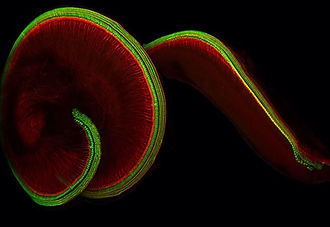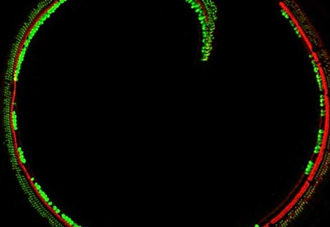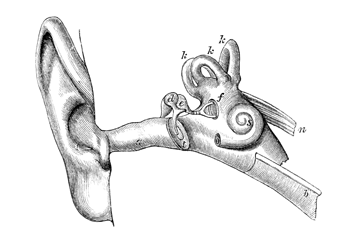Lab News
ASHA Voices: A Promising Outlook for Gene Therapy and Hearing Loss - Podcast, Jeff Holt & Karen Avraham
August 29, 2024
Pioneers Deliver on the Promise of Nature’s Medicine Chest
February, 2024
Result from the first human gene therapy for genetic deafness as reported in the Boston Globe, Science Mag. and NYTimes.
February, 2024
Olga's project on STRC gene therapy for DFNB16 is featured in Harvard Otolaryngology Magazine
Spring, 2022
Gene therapy advance could reverse a common genetic cause of hearing loss
December 15, 2021
Harvard Scientists: 'Smoking-Gun Evidence' Of Key To Hearing In Ear's Hair Cells
August 22, 2018
New research in the journal Neuron converts that "somehow" into a very specific protein, called TMC1, a critical key for hearing. I spoke with Jeffrey Holt, a Harvard Medical School professor of otolaryngology and neurology and a senior author on the paper. -Carey Goldberg, CommonHealth, WBUR (NPR)

USH TALKS: GENE THERAPY FOR USHER SYNDROME TYPE 1C
February 06, 2017
Gwenaëlle Géléoc, PhD
In this USH Talk, Dr. Gwen Géléoc shares exciting news on progress made towards gene therapy for Usher syndrome type 1c. Working with a mouse model of a human mutation, Dr. Géléoc and colleagues delivered a normal copy of the Ush1c gene to the inner ear soon after the mice were born. This led to robust improvements enabling profoundly deaf and dizzy mice to hear sounds at the level of whispers and recover proper balance function. Dr. Géléoc is cautiously optimistic that successes in the lab will someday lead to novel therapeutic approaches in the clinic.

An inner ear in a dish
May 24, 2016
Vector Blog, Boston Children’s Hospital
Could regenerative techniques restore hearing or balance by replacing lost sensory cells in the inner ear? Lab-created inner-ear organs, described today in Nature Communications, could provide helpful three-dimensional models for testing potential therapies.
A happy coincidence for Irish tot with cochlear implants
December 22, 2015
The thing about clichés is sometime they are just spot on. “It’s small world after all,” sprung to mind when I heard about how hearing-restoration researcher Jeffrey Holt, PhD, met Roisin Morgan, an Irish toddler with hearing loss, on an Aer Lingus flight from Dublin to Boston. Read Holt’s recount of their meeting, and watch the reunion video.
Science Friday NPR: Gene Therapy Aims to Switch on Hearing
November 13, 2015
In this segment of Science Friday, guest host John Dankosky discusses gene therapy for the ears with Holt and Lustig. And Mary Harris of WNYC’s Only Human podcast brings us the story of the deaf composer Jay Zimmerman and his dilemma over whether to attempt treating his hearing loss with gene therapy.

Deaf mice cured with gene therapy
September 01, 2015
Reuters: Boston, Massachusetts - In a laboratory at Boston Children’s Hospital a cure for genetic deafness is taking shape. Lead researcher Jeff Holt says that if all goes as planned, children of the future who lose their ability to hear due to genetic mutation will never go deaf.
Gene therapy restores hearing in deaf mice
July 08, 2015
Vector Blog, Boston Children's Hospital
More than 70 different genes are known to cause deafness when mutated. Jeffrey Holt, PhD, envisions a day when patients with hearing loss have their genome sequenced and their hearing restored by gene therapy. A proof-of-principle study published today by the journal Science Translational Medicinetakes a clear step in that direction, restoring hearing in deaf mice.
Lady Gaga at High Volume Drives Hearing-Loss Drug Search
January 07, 2015
Jeff comments on: “Drug Makers Try Gene Therapy” on Bloomberg
Thinking With Your Feet: How Soccer Rewires Your Brain
June 10, 2014
NPR affiliate – WBUR
Read Jeff’s Commentary on Soccer and the Human Brain
Jeffrey Holt: Every artful touch of the ball, exquisite pass, explosive burst of speed and thundering shot on goal, begins in the cortex of evolution’s greatest achievement: the human brain. In this photo, Serbia's Nemanja Matic (14) goes up for a header against Panama's Armando Cooper (11) during the first half of an international friendly soccer game in Bridgeview, Ill., Saturday, May 31, 2014. (Paul Beaty/AP)
Hearing restoration has a sound future
May 09, 2014
Vector: BCH Science and Clinical Innovation Blog
This post is adapted from a commentary in this week’s edition of Science byJeffrey R. Holt, PhD, and Gwenaelle S. G. Géléoc, PhD, of the Department of Otolaryngology and F.M. Kirby Neurobiology Center at Boston Children’s Hospital.
Implant Injects DNA Into Ear, Improves Hearing
April 24, 2014
Deaf people get gene tweak to restore natural hearing
April 23, 2014
New Scientist
Jeff comments on: "Deaf People get gene tweak to restore natural hearing"
People who have lost their hearing will be injected with a harmless virus carrying a gene that should trigger the regrowth of their ears’ sensory receptors
How things work: Scientists find cellular channels vital for hearing
July 31, 2013
Vector Blog –Boston Children’s Hospital
Each sensory cell, of which the human ear has about 16,000, has tiny hairs tipped with TMC1 and TMC2 proteins. When sound vibrations strike the bundle, it wiggles back and forth, opening and closing the TMC channels. When open, the channel allows calcium into the cell, initiating an electrical signal to the brain relayed by the 8th cranial nerve.
Gene-therapy trial will attempt to restore hearing in deaf mice
November 29, 2011
Vector Blog – Boston Children’s Hospital
Mice with deletions of both TMC1 and TMC2 (four panels at left) have auditory hair bundles that look like those of normal mice (right panels), but don’t convert sound waves to electrical impulses. The bottom row shows the bundles in closeup. (Click to enlarge)
Jeff’s comments on the Calirobics Program
March 17, 2009
NPR affiliate – WVTF
Restoring hearing in humans through gene delivery
November 07, 2007
Genetic Engineering and Biotechnology News
Researchers have an ear for fine motion control
October 22, 2007
Design News
Innovations in Medicine
July 16, 2007
ReachMD – XM satellite radio
Sensory Cells For Hearing And Balance Are Fast-Developing, UVA Researchers Find
September 15, 2003
Science Daily
The functional development of hair cells in the inner ear that mediate hearing and balance takes place over a period of just one day in mouse embryos, according to a study by a research team at the University of Virginia Health System.







































